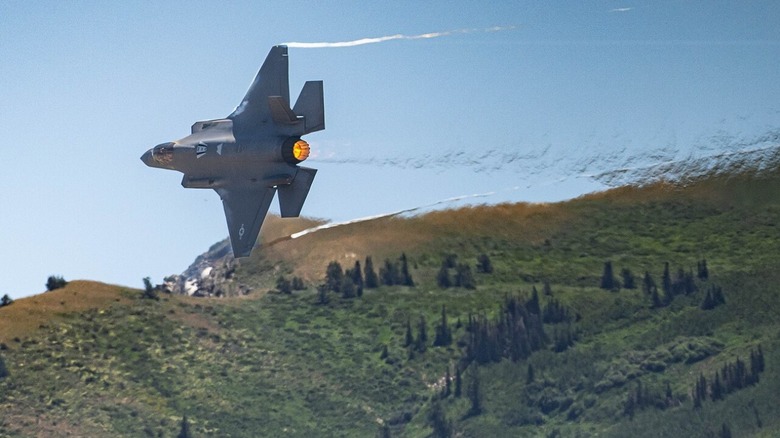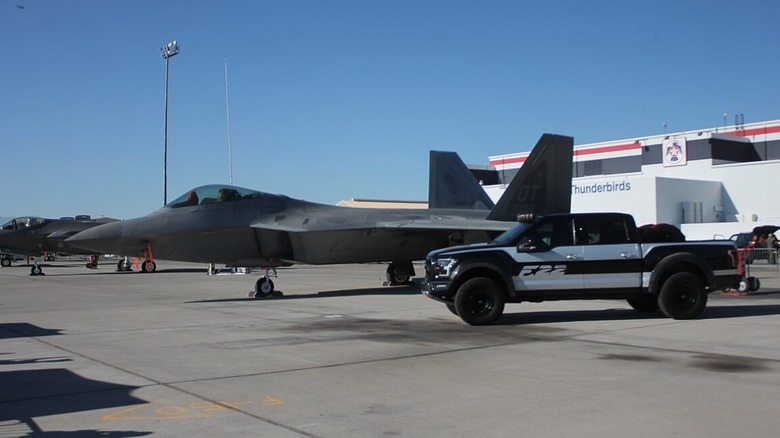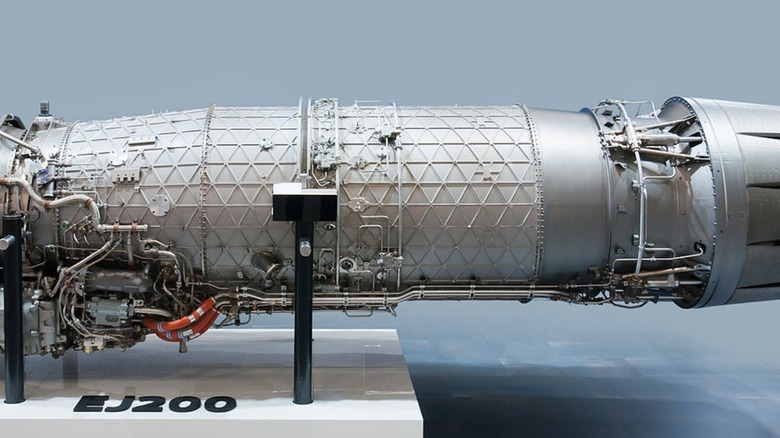 Wikimedia Commons / Micah Garbarino, resized and cropped, Public Domain.
Wikimedia Commons / Micah Garbarino, resized and cropped, Public Domain.
The refinement of the fighter jet seems to have happened at a blistering pace. The world's first operative fighter jet was Germany's Messerschmitt Me 262, which took to the skies during the latter stages of World War II. The first supersonic aircraft with a jet engine, the F-100 Super Sabre, wasn't far behind, with a prototype model making its very first flight in May 1953. Of course, it was the efforts of pioneering engineers, aviators, and other talents from across the aviation industry that allowed these extraordinary firsts to occur. The greatest of those challenges, perhaps, was developing a jet engine. Those engines, too, have come a very long way since the pair of Junkers Jumo 004s that propelled the Me 262 to speeds of up to 540 mph.
The Junkers Jumo 004, singular, offers 1,980 pounds of thrust, a number that has been thoroughly outdone by other fighter jets that have followed in its wake. This is to be expected, of course, all these decades later, but it's still incredible to consider what today's fighter jets can do. Naturally, lots of world militaries would love to lay claim to having the world's most powerful fighter jet, and just as many manufacturers would be delighted to lay claim to having built it. Let's take a look at some of the most powerful jet engines ever made, as well as the thrust, speed, and other potential they provide to the models they power.
The Pratt & Whitney F135 engine
 Wikimedia Commons / Staff Sgt. Kaitlyn Ergish, resized and cropped, Public Domain.
Wikimedia Commons / Staff Sgt. Kaitlyn Ergish, resized and cropped, Public Domain.
Pratt & Whitney clearly sees no need to be modest when it comes to the F135. Wasting no time at all, the brand boasts, "not only is the F135 the most powerful and most advanced fighter engine ever produced, it's also the most dependable." After that, it was incumbent upon the brand to share exactly what the F135 can do in terms of specs.
The most critical spec of this engine is that it can hit an absurd 40,000+ pounds of thrust, putting it comfortably more than 20 times higher than the output of the Luftwaffe's infamous Me 262 engine. The engine is described by Pratt & Whitney as being "the heartbeat of the F-35," a powerhouse of an engine for a powerhouse of a fighter jet. The F-35 needs no introduction, capable of hitting around 1,200 mph (or Mach 1.6) and with an operational ceiling that exceeds 50,000 feet. Its range also exceeds 1,350 miles with a full internal fuel supply (it's also equipped to be refueled from the air where appropriate).
With these virtues in mind, the F135 engine is a vital part of making the F-35A Lightning II one of the most capable and versatile fighter jets around. It was introduced during 2001's Joint Strike Fighter program, as a fifth-generation replacement for models such as the long-serving F-16 Fighting Falcon. It has a suite of advanced features including the Electro-Optical Targeting System and a varied repertoire of weapons that can be customized to the job at hand. The engine itself boasts its own sophisticated features, including the capability to reduce its thermal signature (thereby making it more difficult to track) and the in-built capacity to monitor its performance. The idea behind the whole package is to perform for as long as possible.
The F119 engine
 Wikimedia Commons / Noah Wulf, resized and cropped, CC BY-SA 4.0.
Wikimedia Commons / Noah Wulf, resized and cropped, CC BY-SA 4.0.
Maneuverability is the priority, unlike other aircraft like commercial jets, which take a steady, sensible route to their destination, the flight of a fighter is far less predictable. It may be required, for instance, to blast the afterburners, a maneuver that can drastically boost the thrust of the aircraft in exchange for a similarly dramatic drop in fuel efficiency. As such, the maximum thrust that a fighter jet engine can achieve will often take into account afterburner use.
Not all fighter engines have access to this functionality, which is activated by burning fuel directly into the chamber for a short, sharp, burst of remarkable speed, but some don't even need it. A step beyond afterburner use, for those even rarer models capable of it, is supercruising. Pratt & Whitney's F119 engine can do this, and it puts it to excellent use in the case of the F-22 Raptor.
The F-22 Raptor excels in acceleration can generate a thrust of 35,000 pounds from each of its F119-PW-100 engines, with the pair of them hitting 70,000 pounds of thrust together. The F-22 has even more tricks up its sleeve, though, with a capacity for thrust vectoring as well. With this increased versatility, the F-22's pilot is able to not only generate an enormous amount of thrust, but has much more control over it. They can direct that thrust to a limited extent (approximately 20 degrees above or below where it began), thereby allowing for a broad range of motion that other models simply can't offer. This explains the broad range of takeoff and landing maneuvers that the Raptor can perform, and it's because of its remarkable and multi-faceted engine that it can do so. Nonetheless, other fighter jet engines are, in their own ways, just as impressive.
The AL-41F1S engine
 Wikimedia Commons / United States Air Forces Central, resized and cropped, Public Domain.
Wikimedia Commons / United States Air Forces Central, resized and cropped, Public Domain.
We have seen some astonishing U.S. fighters so far, but other nations have also devised some incredible engines for these flying machines. In the Russian military, for example, it's difficult to top the AL-41F1S, which is the powertrain for the formidable Su-35 fighter. This is another model equipped with an afterburner, and when using it, it's capable of thrust as high as 32,000 pounds.
Though this isn't quite enough to top the output of some jet engines on this list, it's a critical part of making the Su-35 the formidable fighter that it is. It can carry a mighty payload, including a Gryazev-Shipunov GSh-301 autocannon and R-37M missiles, but its practical use of them is limited by the aircraft's potential. Here, there's nothing to fear, as developer Rostec declares the model to be a Generation 4 ++ fighter and explains that this means it's considered "a deeply upgraded version of the [Sukhov Su-27] whose specifications, except the stealth design, correspond to the fifth-generation fighters."
It can also supercruise, tops out at above Mach 2, and boasts thrust-vectoring functionality that affords it more freedom to make landings on runways that some comparable aircraft couldn't. The capabilities of the Su-35 have been well known for a long time. In November 2023, Yury Ignat, a spokesman of the Ukrainian Air Force, told Rada TV that "To win air supremacy, we need aircraft with tactical and technical characteristics that are not inferior to Su-30, Su-34 and Su-35." The Su-35, then, is the most sophisticated in a line of advanced aircraft, and it's the AL-41F1S engine that pushes it to perform as it does. Indeed, Rostec explains that "a more powerful AL-41F-1S thrust-augmented engine is one of the key innovations ... compared with the previous aircraft in the family."
The EJ200 Engine
 Wikimedia Commons / Julian Herzog, resized and cropped, CC BY-SA 4.0.
Wikimedia Commons / Julian Herzog, resized and cropped, CC BY-SA 4.0.
This next engine is the product of an international partnership known as EUROJET, which pulls the expertise of ITP Aero, MTU Aero Engines, Avio Aero, and the iconic British brand Rolls-Royce. Its EJ200 is best known as the powerhouse that propels the Eurofighter Typhoon, one of the best fighter jets ever built. It boasts 13,500 pounds of thrust without implementing its afterburner, rising to 20,000 pounds with it in use. Eurofighter declares that the engine was designed to be light and low-maintenance, to the extent that its "advanced integrated health monitoring" allows it to fly for up to 1,200 hours before requiring anything more than routine maintenance. Its weight, meanwhile, is low to bolster the aircraft's performance, while allowing it to store significant fuel (approximately 7,600 kilograms) to retain a high level of range.
The Royal Air Force reports that the Typhoon uses two of these turbofan engines, and it was first used in combat in Operation Ellamy in 2011. It sports devastating weapons like Brimstone 2 and Meteor missiles, as well as sophisticated instrumentation, including a Captor ECR 90 radar. As would often be expected of one of the most advanced fighter jet engines in the world at present, the EJ200 is scheduled to play a critical role into the future, too. In December 2024, a Rolls-Royce press release announced that a new crop of 59 of the engines will begin to be delivered to Spain's air force in 2029, as the continent continues to develop its military capacity. The press release declares, "With its unprecedented performance record, combined with multi-role capability and highest availability at competitive life-cycle costs, the EJ200 engine is perfectly set to meet air force requirements both for today and for the future."
The XF9-1 engine
 Wikimedia Commons / Hunini, resized and cropped, CC BY-SA 4.0.
Wikimedia Commons / Hunini, resized and cropped, CC BY-SA 4.0.
Some of the most iconic fighter jets in the world, ranging from the F-35 Lightning II to the Su-35 already discussed, are developed in the United States and Europe. In the rest of the world, of course, some remarkable innovations in this area are still being made. Japan's XF9-1 engine is one example of a technology that could have a huge impact on the future of fighter jet development. As reported by Defence Security Asia in June 2025, this engine is the model that Japan has thrown into the ring as a potential candidate for the powertrain of an upcoming Indian project. The latter nation is working on its Advanced Medium Combat Aircraft initiative to develop a new fifth-generation fighter, and needless to say, a potentially lucrative contract developing components for it is highly coveted.
Japan's new XF9-1 isn't operational as an existing fighter jet yet, as of the time of writing, but it has formidable potential. The engine, Defence Security Asia reports, is "one of the most advanced low-bypass afterburning turbofan engines developed globally," and manufacturer IHI outfitted the model with an afterburner that can achieve upwards of 33,000 pounds of thrust (slightly over 24,000 pounds of thrust without it in use). The outlet reports that the developing XF9-1 engine family is expected to be capable of more than 44,000 pounds of thrust in the future. It's certain to have an enormous impact on the development of fighter jets, both in its home region and beyond. India's Advanced Medium Combat Aircraft, in whichever form the final aircraft may ultimately take, is probably going to take until around the mid-2030s to be completed. When it does, though, it could prove to be a real powerhouse to reckon with.




